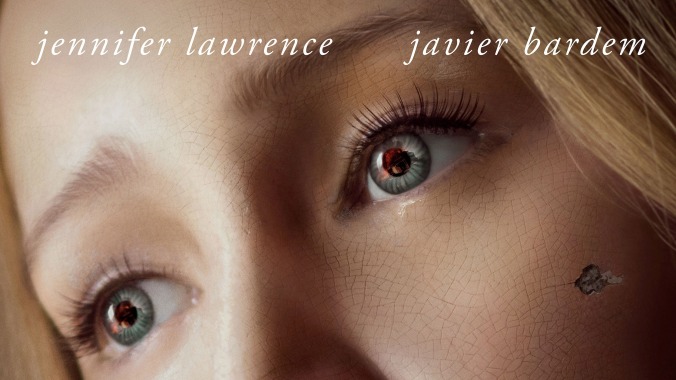Darren Aronofsky’s preoccupation with paranoid, physically grotesque searches for meaning—a curious mix of deep-think and makeup effects that goes back to his black-and-white debut feature, Pi—grimly paints humanity as a species defined by obsessions, addictions, delusions, and self-destruction, its only prophets being madmen. But now Aronofsky is something of a madman, too; he’d have to be to make Mother!, a delirious allegory that lets loose various subtexts and criticisms of the Bible (e.g., God as an inconsistently written character) to rewrite scripture as surreal psychological horror, with the human race as uninvited guests pissing and screwing where they don’t belong and their creator as a husband who might be gaslighting his wife. It’s almost unbelievable that something this narratively arty is being released as a mainstream horror movie, but the filmmaking ranks as some of Aronofsky’s most skillful.
Taking inspiration from classic Roman Polanski films like Repulsion and Rosemary’s Baby—which is pretty damn subversive, considering the context—Mother! pictures creation as a creepy house in a clearing, with no mailbox or road. Inside live a young homemaker (Jennifer Lawrence) and her considerably older husband (Javier Bardem), a famous writer in a long creative slump; he broods in his upstairs study while she busies herself with housework and remodeling. (The characters’ names are never spoken out loud; anyway, they have many.) One night, a gruff stranger (Ed Harris) appears at the door and is inexplicably welcomed by the husband, even as he annoys the wife with his clumsiness, bad manners, and faux pas. The stranger’s own wife (Michelle Pfeiffer) shows up the next morning, followed by more and more visitors; rapidly, the home devolves into a dark farce and then a violent nightmare of cannibalism, cultism, and genocide, gruesomely parodying the narrative of Christianity, from Genesis to the gospels and beyond.
As unlikely as it may sound, this elaborate meta-textual pastiche actually delivers the expected shocks and goosebumps, obsessing its way into something resembling a horror film. With the logic of a dream, it pieces together domestic fears and gothic elements: a locked room, a cold basement, notes of psychosexual unease, unwelcome guests, a missing child. In what turns out to be his boldest move, Aronofsky confines almost the entire thing to the Lawrence character’s claustrophobic, disoriented perspective, her face often framed in chin-to-forehead close-ups, while the other characters are seen over her shoulder. Think of her as everything left out of the traditional, turbulent image of God—but also as a point-of-view character in a horror movie, trying to orient herself in an increasingly senseless, distorted reality that eventually collapses into an overlong hallucination of the shittiness of humankind.
One might call it critique by way of self-obsession. The material is almost oppressively personal, from the homages—to Polanski, Eraserhead, and Days Of Heaven, among others—to the religious and environmental concerns to the seemingly self-critical characterization of Bardem’s writer (think, “In the beginning was the Word…”) as an abusive and vampiric male creative ego, prone to mood swings and craving attention. (Aronofsky himself claims to have written the first draft of the script in five days, which is rich.) The house in the clearing is as much the writer-director’s artistic inner cosmos as it is a stand-in for our planet, its eternal cycle of creation and destruction a pessimistic take on the artistic process. Or is it the other way around? For now, one question begs to be answered: How did an American studio agree to make this film?


 Keep scrolling for more great stories from The A.V. Club.
Keep scrolling for more great stories from The A.V. Club.